Little spots of oil on your windshield and inside your cowl—that’s how it starts. Or it can happen all at once: A plugged breather can pop the front crank seal out of your Lycoming in one big burst, and then you’ll be landing with a windshield full of oil and have quite the belly mess to clean up as well. While not exactly common, a front seal leak on a Lycoming-type engine does happen—and if you fly long enough, you’ll probably be faced with the job of replacing one. The good news is, while it sounds like quite an ordeal, changing the seal is not that big of a job, once you commit to doing the job right.
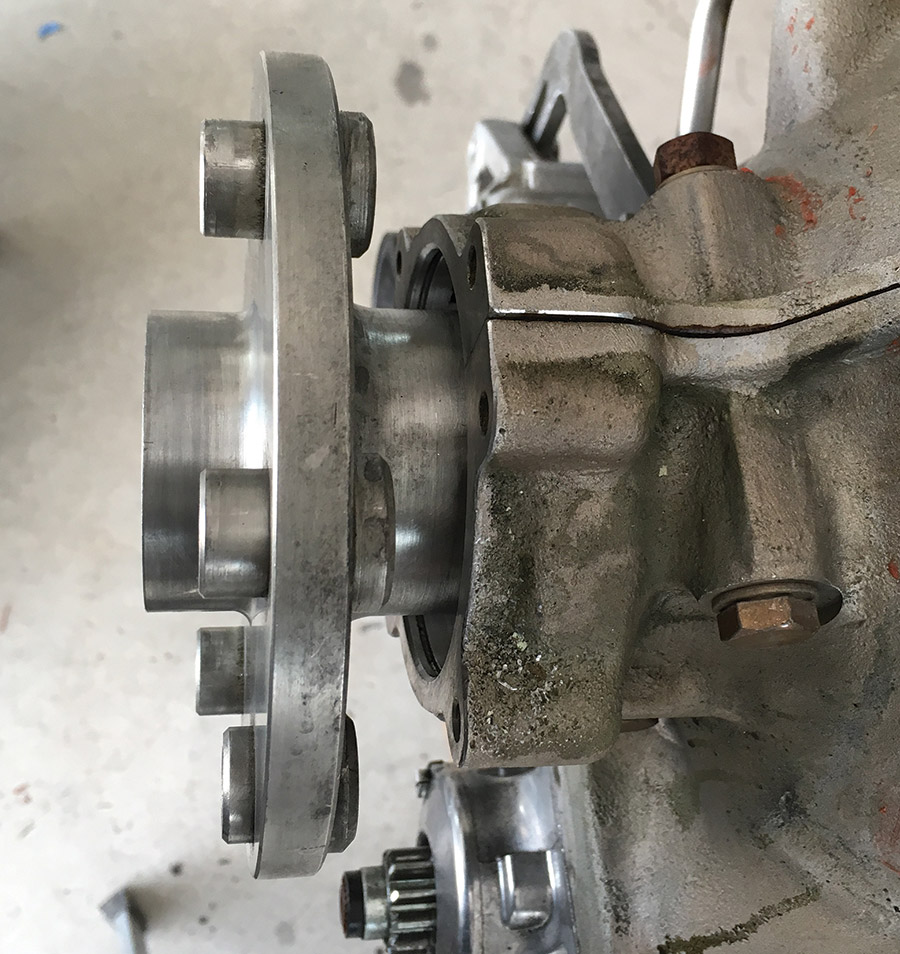
The prop flange and crankcase nose end with the old seal already removed. This is the time to polish the crankshaft to remove any scratches.
The front seal on the typical direct-drive Lycoming is a ring of rubber about 4 inches in diameter. It nestles into a cavity in the front of the crankcase, fastened from turning with nothing more than adhesive. The inside diameter is a seal that rides on the crankshaft—and with a little help from a thin coiled spring—keeps the oil in the crankcase from escaping to be flung all over the inside of the flywheel, and then to places all over the cowl and beyond. The important thing about replacing the seal is to keep the part that rides on the turning crankshaft in perfect condition while keeping the outside diameter neatly (and securely) glued to the bore of the case.
Lycoming has a useful and detailed service instruction, number 1324C, that covers the job. While it contains a lot of great information that you should definitely read, it is a little sparse on the how-to details when it comes to cleaning and gluing.
Crank seals come in two flavors: a solid, continuous ring and one that is identical, except that it has a split, so that it can be installed without stretching it over the prop flange. The split seal is part number 78443, and the solid type is P/N LW-15628. Most gasket sets come with one of each. I’ll be honest—I have never heard much about anyone having good luck with the split seals. Their biggest claim to fame is that they can be installed without a special tool to stretch them over the flange. But as I’ll show you, this isn’t as big a deal as folks make it out to be. The split seal is, by its very nature, starting out with a place for oil to leak. You still have to remove the prop and flywheel to install it, and there is a good chance that the new seal will leak again, so why not go for the gusto and do the job right?
Off with the Old
We’ll start by assuming that you have removed that prop and flywheel—not hard to do, but somewhat tedious if you have a constant-speed prop and have to turn those attachment bolts a few short turns at a time, then go to the next one. Allow yourself an hour for the job, and you’ll be surprised when you’re done in (a little) less time. If your prop and engine have been balanced, make some marks with a Sharpie to remind you how it goes back together. The same is true for the flywheel: Keep the indexing the same so that you save yourself annoyance later on.
Once you’ve got those big things out of the way, the next thing you’ll see is the front face of the old seal. By the way, check the inside of the flywheel at this point. If it is dry without oil, you do not have a seal leak, and my feeling would be to put things back together and leave well enough alone.
But let’s assume that you do have a leaky seal. In that case, you can dive ahead and take that leap of faith that you will successfully install the new one because you’re sure to destroy the old one getting it out. Use a combination of pointed tools to stab the old seal—dental picks will probably be too weak for the job, and automotive seal pullers may be too large. I find that a medium-size right-angle pick, stabbed right into the front face, is the best approach. Lever the seal out, but be careful not to scratch the crankshaft in any way. This is one of those jobs that seems impossible about a minute into it, and five minutes later, you’re done and saying, “Well that really wasn’t that bad.”
Keep It Clean
The next thing you need to do is clean the bore. This is definitely worth taking the time to get right. The inside of the bore will be coated with old adhesive, and you need to get this out. Acetone is the recommended cleaner, and I find that starting with a heavy-duty paper towel soaked in solvent gets the heavy stuff cleaned up.
After that, I like to cut a strip of soft Scotch-Brite, one that I can push into the bore between the crankshaft and the case. I soak that in acetone, and work it into the gap with a plastic tool. The handle of a toothbrush works, but my latest work has been done with a modern bicycle tire “iron.” Miniature versions of metal tire irons used for motorcycles, these 3- or 4-inch pieces of plastic are the perfect shape and size to fit into the gap behind the prop flange. Stuff the soaked Scotch-Brite into the gap, then work it around the bore with the tire iron. It might not seem like you’re cleaning things very well at first, but the acetone will soften the old adhesive and, with patience, you’ll have nice clean metal for the new bond to grip.
Use a mirror and flashlight to inspect the cleaned bore all the way around. It needs to be clean and shiny, with no residual trace of the old adhesive. Take the time to do this right, or you’ll be redoing the entire job. Think about the time it took to get the prop off (and what it will take to get it back on), and use a whole afternoon if you need to for this step. Clean up the crankshaft as well; I like to use Scotch-Brite here, too, as it is less aggressive than sandpaper. Remove all scratches or surface defects (without reducing the diameter at all).
Once you have polished the crankshaft and cleaned the bore, clean them both again with acetone. This is a surgical job, and you want no contamination. Work with rubber gloves on to keep any dirt or oil from the surfaces. Next, cut a thin strip of paper that will wrap around the crankshaft and fit into the bore. This is to protect the shaft while you apply adhesive to the bore. Wrap paper around the shaft, and put a little piece of tape on it. Slide this back into the bore as far as it will go.
On with the New
Now you have your choice of adhesive. Lycoming recommends either Dow Corning 737 or (as an alternative) Pliobond 20. Being an old-fashioned guy, I have always been fond of Pliobond, despite its skunk-like smell. It dries quickly and has always worked well for me. I like to apply it to the bore before stretching the seal because there is a lot more open space. You do, however, need to be ready to get the job done once you apply it to the bore; it is a contact cement that will dry too much for a good bond in 30 minutes or so. I use an acid brush (they are really cheap) to apply the Pliobond to the bore, making sure it covers the entire surface, all the way around. It dries slightly brown, making it easy to see where you have gotten a good coat and where you need a little more. Use a mirror and light to get this coat complete and even. Once you’ve done this, you can remove the paper wrap and, once again, stare at your shiny crankshaft.
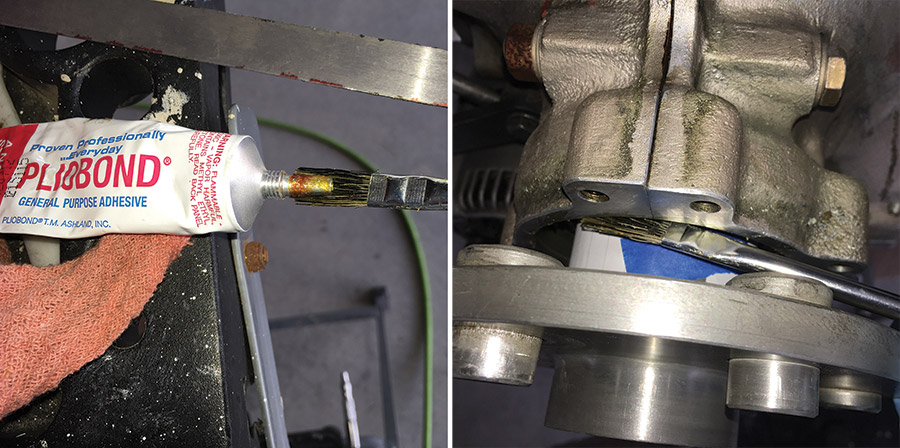
Apply Pliobond to the acid brush and then into the crankcase cavity. With a piece of paper covering the shaft, you can use an acid brush to apply Pliobond all the way around inside the cavity.
Next comes the big stretch. Looking at the solid seal, then looking at the flange, you’ll swear that there is no way one will stretch over the other—but it works! The first step is to remove the spring. You are going to be giving the rubber quite a workout, and you don’t want to damage this critical component, so unhook it and carefully set it aside. Don’t lose your grip, or you’ll be looking all over your shop for the devil. This is where having two seals (one split, one not, but both with a spring) in the kit is useful. Trust me—you might just need that extra spring! I like to heat the seal to the temperature of boiling water to make it just a little more stretchy, but I have never measured the stretch either way, and I have seen engine builders do this cold. So if it makes you feel better, boil it and apply it hot. If not, do it cold.
Put your pin through a bolt flange, then hook the seal over both the forward and back ends of the pin. Make sure that the seal is front face up so that it will end up going on the correct direction. Now slip your stretching tool (see sidebar) into the seal, seat it on the flange, and begin working it around. You’ll have to pop the seal over the rest of the bolt flanges, as well as the front end of the crankshaft—and while it seems impossible, it will actually work. Once you get halfway around, you’re at maximum stretch, and it gets easier from there. As it pops into place behind the prop flange, you’re allowed to congratulate yourself; you’ve now done a real, honest Lycoming assembly task!
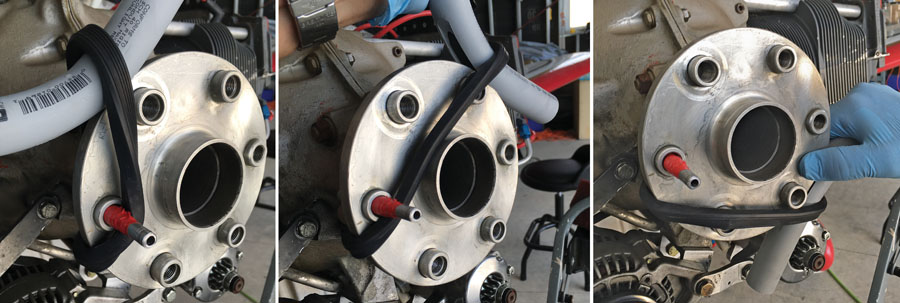
(Left) Beginning to stretch the seal. The pin holds it in place, and the homemade stretching tool works it over the flange. (Center) Note the groove in the bottom of the tool—this centers it on the flange. You have to manually work the seal over the boss on the front of the flange. (Right) Almost finished with the big stretch—the hard part is over.
The service instruction recommends a little grease to get the seal over the flange, but I have found that it works fine without and eliminates any possibility of contaminating the adhesive surfaces with something that will definitely cause a bond failure. You can do it with grease, but then you’ll have to get the acetone out again to clean the seal. And good luck not getting solvent on the recently applied glue in the bore. Remember—the quality of this bond is what is going to keep the seal in place and prevent you from doing this all over again.
Spring Time
Next up is installing the spring. It’s easy to forget this in the glow of success of stretching the seal. It’s also easy to launch the spring into parts unknown if you’re not careful, so keep a good grip. Hook it behind the seal, then use a couple of dental picks to ease it into the groove in the seal. Once again, inspect all the way around; it might not be in place behind the shaft where you can’t see.
Once again, take out the adhesive and apply it evenly to the outside of the seal. The seal has grooves on the outside to better hold the adhesive. Make sure not to get adhesive on the crankshaft or the sealing lip of the rubber part. Let this dry, and you’ll be ready for the final step: pushing the seal into place.
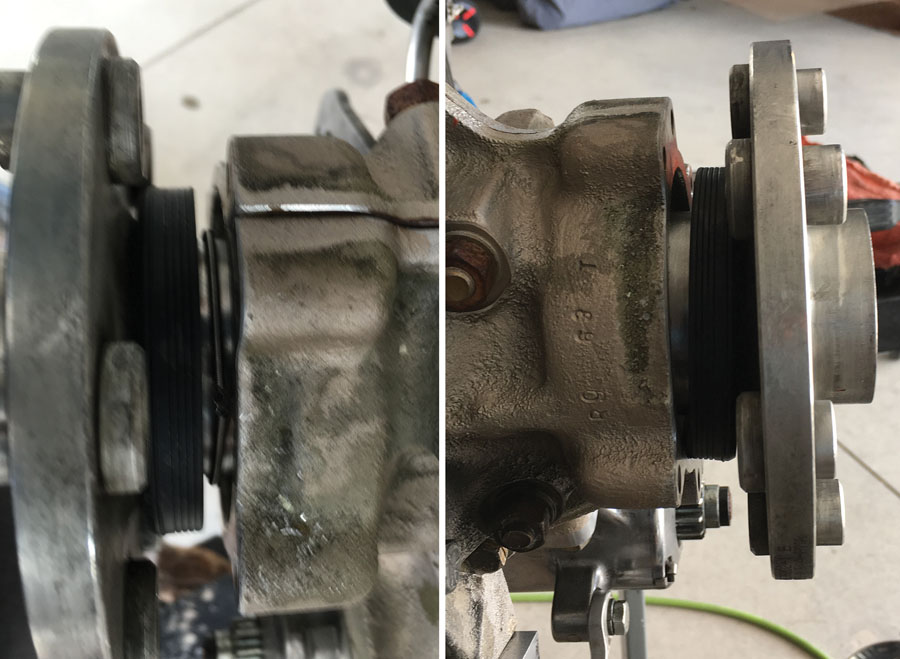
(Left) With the new seal on the shaft, install the spring, clipping the two ends together, then moving it into the groove on the back of the seal. (Right) The seal is ready to install, with Pliobond in the crankcase nosepiece and on the outside of the seal.
Once again, this is where I pull out the plastic cycling tire irons (they’re really cheap, by the way, typically priced at less than five bucks for a set of three, and usually on the cash register counter in your local bike shop). After pushing the seal partly into position with my fingers, I seat it firmly by pushing it in with the irons. Remember, this is a contact cement job—get the pieces into final position quickly, or they will glue themselves in the wrong position…quickly. Check that you have pushed the seal all the way in, nice and even and flush with the front face of the crankshaft bore. Now leave it alone to cure.

(Left) Use a nylon tire tool from a bicycle shop to push the seal into position without damage. (Right) The bicycle tire iron is the perfect size and shape to push the seal in place.
How Long?
The service instruction says allow 24 hours for Dow 737 to cure. Pliobond says it cures in 30 minutes. I just like to walk away from the whole thing at this point and let it sit (at least) overnight. Don’t turn the crankshaft, and don’t get into a rush. You don’t want to do this over. Come back the next day, install the flywheel and prop (don’t forget the alternator belt!), and you’re done.
Replacing this seal is something that, if done right, you will not have to do often—or ever again until overhaul. The keys are clean, smooth surfaces and a good bond, which can be achieved with even application of adhesive. It’s not hard, but there is that magic moment of stretching the seal that takes a little faith. If you’re faced with a leaking seal and wondering if you can do this, just remember: Most mechanics have only done it a few times (if that) themselves…so what have you got to lose by giving it a try? Most likely, you’ll end up being the airport expert on the job, and that comes with bragging rights, plus the opportunity to practice the skills again on your friend’s engine.

![]()
Paul Dye, KITPLANES Editor in Chief, retired as a Lead Flight Director for NASA’s Human Space Flight program, with 40 years of aerospace experience on everything from Cubs to the Space Shuttle. An avid homebuilder, he began flying and working on airplanes as a teen, and has experience with a wide range of construction techniques and materials. He flies an RV-8 that he built, an RV-3 that he built with his pilot wife, as well as a Dream Tundra they completed. Currently, they are building a Xenos motorglider. A commercially licensed pilot, he has logged over 5000 hours in many different types of aircraft and is an A&P, EAA Tech Counselor and Flight Advisor, as well as a member of the Homebuilder’s Council. He consults and collaborates in aerospace operations and flight-testing projects across the country.

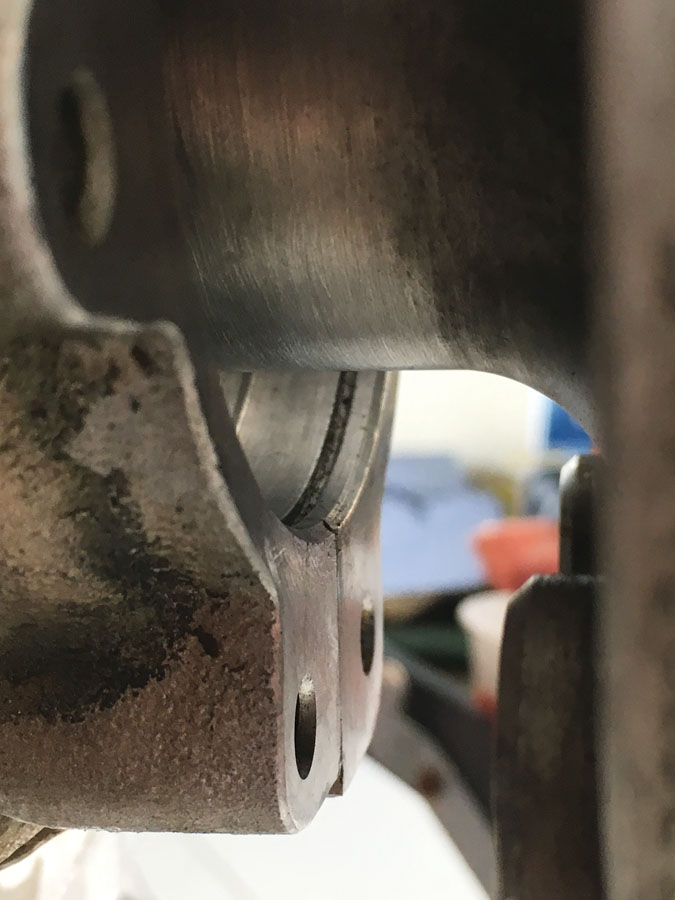










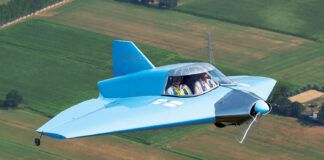
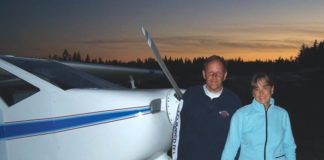
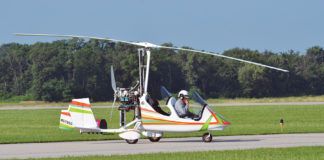
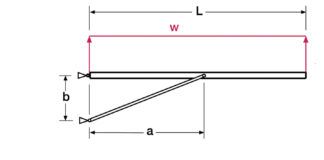
I used this article today to help me do my front seal, it all worked great. And this isn’t the first time I did something to my plane in which advice gleaned from Kitplanes helped me out! Thanks!